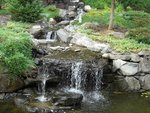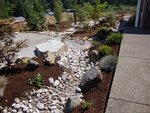

Nothing adds harmony to a garden or yard like water. If done right, water adds a peaceful ambiance to the landscape, not to mention it looks great.
If you can get a water fixture to blend in naturally with the surroundings of your home’s landscape it has a chance to be quite a nice looker, but there are several fixture options, and several yard types out there, and not all of them blend seamlessly. Here’s a look at the best ways to waterscape a home property. Keep in mind that many of them can be combined together.
Waterfall
The sound of flowing water is infectiously soothing. Common designs include an array of rocks with multiple layers that the water moves down. In a lot of cases a waterfall will have multiple small waterfalls within it. Usually the runoff will dump into a ground level pond at the bottom, but that doesn't have to be the only end point. Streams and drains work too.
According to Scott Esteb, president of Boulder Falls Landscaping in Clark County, waterfall features are generally the most expensive day-to-day water fixture installations because they’re typically larger scale than ponds, bubblers or streams.
In Esteb’s expertise, typically a nice waterfall will have two to five layers of falls and then will end with a bigger fall that’s about two to six feet high. This height range is perfect because anything shorter won’t allow for much of a true waterfall and anything higher will cause more noise and splash than probably intended.
For that last fall, Esteb said picking the right rock for the water to flow off of is very important. Often times he says he sees people stick a “totally flat” rock there so that the water will flow smoothly off it, but that’s not necessarily what you should do.
“You don’t want a straight, even fall, it won’t look natural and that’s the key,” Esteb said.
Instead he said you want a rock that’s “on the flat side” but has some curves and texture so the runoff looks less staged.
Pond
Putting in a waterfall with a pond can get expensive, but if you’re dead-set on having a significant body of water around, consider a pond.
With a pond the biggest thing to be cautious of, especially in the Pacific Northwest, is flooding from excessive rain. Esteb said any new pond needs to have an overflow drain installed into it.
“It will basically just act like a gutter, so the water never rises higher than you’ve intended,” he said.
If you have a combined pond/waterfall, he also jokes that if the water rises too high there won't be a waterfall to observe.
Inside of ponds people also enjoy adding fish. For those who want to do so Esteb said to make sure the water is at least two or three feet deep. He adds that if you want them to last several years it’s advised you give them places to hide at the bottom.
Stream
With streams there are two approaches, one with man-made flowing water, and the other with natural water. Man-made streams are more expensive, but will be more decorative because it’s easier to control. Esteb said the other option of no water is great for practical reasons, the biggest being drainage around the house.
“Dry creek beds can help divert the water away from gutters,” he said.
With all the rainfall Southwest Washington receives, it’s not like a “dry creek” is really going to be dry all that often.
Bubblers
A final water fixture category, according to Esteb, is bubblers. Bubblers are lifted fountains, usually via tall rocks that spout water up and let it flow down to the ground. With these, Esteb said medium-sized stones are the best thing to place underneath because they will fill up the small bed of runoff water that gets filtered back to the top without much notice.
Unlike waterfalls and ponds, Esteb said you can get away with not having a drain installed around a bubbler, but to just be mindful of the location it’s at in case you do.
Advice for all water fixtures
With all fixtures, Esteb said adding vegetation will add a nice framing to the look. One caution he said though is any plants with leaves are bound to result in more cleanup.
According to Esteb a general rule of thumb with all water fixtures is the further away from the house you go, the bigger your fixture should be. Near the house (especially patio areas) he said bubblers blend in well, and around the house streams will look nice. Once you move out into the heart of the yard is when he suggests going with ponds and waterfalls.
With man-made decoration, Esteb said anything goes, but a popular unnatural decor to be cautious of is lights. With them he advises low voltage.